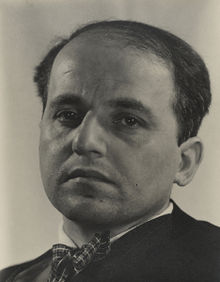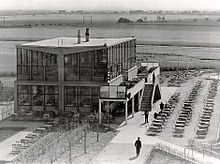Hans Wittwer
Hans Wittwer | |
|---|---|
 Hans Wittwer, c.1929–1934 | |
| Born | 4 February 1894 Basel, Switzerland |
| Died | 19 March 1952 (aged 58) Basel, Switzerland |
| Education |
|
| Occupation(s) | Architect, Academic |
| Employers |
|
Hans Wittwer (4 February 1894 – 19 March 1952) was a Swiss architect who worked in Germany and who taught architecture at the Bauhaus art school in Dessau. He was a proponent of functionalist architecture; the idea that form follows function. He worked with the Bauhaus director Hannes Meyer both at the school and in a joint architectural practice in Basel. He also taught at the Kunstgewerbeschule Burg Giebichenstein in Halle.[1]
Life and Work

Wittwer was born in Basel, Switzerland on 4 February 1894.[2]
He began studying architecture at
In 1926, Wittwer founded his own architectural practice in Basel, which he co-directed with Hannes Meyer.
When Meyer was invited to lead the newly formed Building department at the Bauhaus in 1927, Wittwer joined him, teaching building theory and technical design, where he introduced new teaching practices. Later, he was head of the construction office of the Building department.[9] In Meyer and Wittwer's building theory classes, students were taught to scientifically analyse both the client's requirements and the site conditions. Students carried out environmental studies at the site, such as how the sunlight entering the buildings would change during the day. The aim was to create functionalist buildings which put users' needs at the centre of the design and which took account of the natural conditions of the building site.[10]
While working together at the Bauhaus, Wittwer and Meyer led the design and construction of the ADGB Trade Union School in Bernau bei Berlin (1928–1930). Students from all areas of the Bauhaus were involved in this work. In 2017, the ADGB school, which is considered an outstanding example of Bauhaus functionalist architecture, was inscribed as part of the World Heritage Site called the Bauhaus and its Sites in Weimar, Dessau and Bernau.[11]
Following conflicts with Meyer, in 1929 Wittwer left the Bauhaus to become Head of Architecture at
At the same time, he also worked as an architect for Leipzig/Halle Airport, designing a glass-walled airport restaurant, built 1930–1931. It had light fittings made in the Kunstgewerbeschule metal workshop, led by Karl Müller, curtains from the weaving workshop led by Koch-Otte and the "Hermes" crockery service designed by Friedländer.[12] The building, along with most of the airport, was destroyed in a World War II air raid on 16 April 1944.[15]
In 1933, when the Nazis came to power, Wittwer was dismissed from both the art school and his consultant role to Merseburg city council. Marcks, Consemüller, Koch-Otte, Friedländer and others were also dismissed from the art school at the same time.[13] He stayed in Halle for another year, working as a self-employed architect. In 1934 he returned to Basel where he worked for his parents' company and no longer practised architecture. He died there on 19 March 1952, aged 58.[1][12]
References
- ^ a b Bauhaus Denkmal Bundesschule Bernau. Biografie Hans Wittwer. Retrieved 7 May 2019
- ^ Wittwer, Hans-Jakob (ed.) (1985) Dokumente zur Modernen Schweizer Architektur: Hans Wittwer (1894–1952) Zürich: gta Verlag
- ^ Bauhaus100. Masters and teachers. Hans Wittwer Archived 2018-11-24 at the Wayback Machine. Retrieved 21 April 2019
- ^ a b Martínez de Guereñu, Laura (2009) Hans Wittwer: Indexes in the Halle-Schkenditz airport (PDF) in ear: theory, art and architecture history journal, no. 6, October 2013.Retrieved 22 April 2019
- ^ Monoskop. ABC. Retrieved 22 April 2019.
- ^ Architectuul. Hans Wittwer. Retrieved 22 April 2019
- ^ Bauhaus100. Competition design for the Petersschule, Basel . Retrieved 22 April 2019
- ^ Kuntz, Joëlle (2 June 2014) Geneve Internationale. Architectural Competitions: Imagining the City of Peace Archived 2019-07-17 at the Wayback Machine. Retrieved 22 April 2019
- ^ Bauhaus100. Training. Building theory. Retrieved 22 April 2019
- ^ Bauhaus100. The “School in the Woods” as a Socio-pedagogical Ideal Archived 2020-06-19 at the Wayback Machine. Retrieved 17 April 2019
- ^ Markgraf, Monika (ed.) (2017) Bauhaus World Heritage Site. Leipzig: Spector Books
- ^ a b c Kulturstiftung Sachsen-Anhalt Protagonisten der Moderne in Halle (Saale). Hans Wittwer. Retrieved 9 May 2019.
- ^ a b Dolgner, Angela (ed.) (1993) Burg Giebichenstein. Die hallesche Kunstschule von den Anfängen bis zur Gegenwart; Staatliche Galerie Moritzburg, Halle, 20. März bis 13. Juni 1993 ; Badisches Landesmuseum, Karlsruhe, 25. Juni bis 12. September 1993. Halle: Staatliche Galerie Moritzburg
- ^ Bauhaus100. Erich Consemueller. Retrieved 9 May 2019
- ^ Hesse, Wolfgang, et al. (1997) 70 Jahre Flughafen Leipzig-Halle. Leipzig: Flughafen Leipzig/Halle GmbH
External links
- Martínez de Guereñu, Laura (2009) Hans Wittwer: Indexes in the Halle-Schkenditz airport (PDF) in ear: theory, art and architecture history journal, no. 6, October 2013.
- Die Protagonisten der Moderne in Halle (Saale). Hans Wittwer
